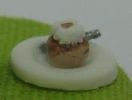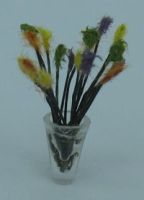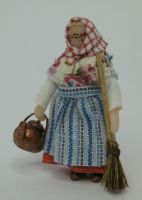Easter is Påsk in Swedish (cf. archaic English "Pasch" or "Pascha"; from Latin which got it from the Hebrew "pesach"). Our equivalent of "Happy Easter" is Glad Påsk. My aim is to give you an idea of Swedish Easter traditions in the last 100 years or so.
Depending on where in the world you live, you might not recognize some terms I'm using below, like e.g. Fat Tuesday, Maundy Thursday, or birching. In that case, you may want to look it up in Wikipedia - that's where I found the translations for many of these words. When I've included Swedish words as well, the Swedish is in italics.
Shrovetide and Lent
Lent (fasta)
To most Swedes, Lent is just a name for the weeks before Easter. Sweden became Protestant in the 16th century, so actual fasting during Lent hasn't been prescribed since. But in some areas, a tradition of abstaining from rich food and avoiding parties, dancing and weddings during Lent lived on into the 20th century.
Shrovetide bun (fastlagsbulle; semla)

A wheat-flour bun, nowadays filled with almond paste and whipped cream. Traditionally they're eaten before Lent, on Fat Tuesday (regionally on Shrove Monday instead), but as today's Swedes don't keep Lent many have them weekly during Lent as well.
In its present form, the semla dates to the early 1900s. Before that, the bun was filled with almond paste only, and either boiled in milk or served in a bowl of hot milk. When prepared this way, it's known as hetvägg (from German "Heißwecken" meaning "hot wedges). We got the idea from Germany, and they were first mentioned in Sweden in 1689. In the 19th century, farmers too had started to eat hetvägg; often a bought bun without filling, served in hot milk - for dinner!
Anther traditional name for the semla or hetvägg is fettisdagsbulle ("Fat Tuesday bun"). Semla long meant only the plain, unfilled, wheat bun itself (from Latin "simila" and German "Semmel", meaning fine wheat flour).
Easter birch (påskris)

During Lent, budding birch twigs are adorned with bright-coloured feathers and set in water to sprout leaves. In addition to the feathers, they may be hung with small, light ornaments in the shape of e.g. eggs, chickens, or Easter witches. (Some use pussy willow twigs for decoration as well, but it's used as is without feathers or ornaments, and isn't called påskris). Florists sell påskris with feathers already attached. Big bunches of them are displayed in buckets, both outside florist shops and in flower stands at markets, looking very bright and cheerful.
In the 17th century, there was a custom of birching each other at Easter as a reminder of Christ's suffering. Over time, it developed into a game, where the first person to wake up in the
morning sneaked up on the sleepers to birch them in their beds. Påskris was used for decoration at least since the late 18th century, when it might be decorated with colorful
ribbons, paper flowers and other embellishments. Feathers have been used on it at least since the mid-19th century. By the 1930s, the påskris had spread all over the country, and
people embellished them with coloured feathers and paper flowers, and pompom chickens.
Holy Week
Easter witch (påskkäring - actually an euphemism meaning "Easter hag")

On Maundy Thursday, some children (mostly girls) dress in a full-length skirt, apron, and headscarf (the essential 19th century farmer woman outfit), and have their faces painted with lipstick red dots on the cheeks and lots of dark freckles. They accessorise with a metal coffee pot (preferably a vintage copper pot) and perhaps a broom, and go out to knock on their neighbours doors for treats, wishing Glad Påsk. The coffee pot is handy for carrying the candy. My little påskkäring is traditional in style; today you often see the kids carrying a modern broom, and wearing a bibbed barbecue type apron, which gives a somewhat different look...
In traditional belief, witches were the most dangerous during the last week of Lent. Later, when people no longer believed in witches, youngsters used the witch theme to have some fun right before Easter. In the early 19th century, they might dress up like witches and then play tricks on people; later in the century they dressed up and went from house to house in the village asking for contributions in money or kind to the youngsters' Easter party. By the early 20th century, it had evolved into the påskkäring custom of today.

Cute as today's Easter witches may be, in the 17th century witches and children were a deadly combination. In the years 1668-1676 about 300 people, mosly women, were executed in witch trials in Sweden (a part of the Inquisition that spread to Protestant countries as well). The witnesses at the trials were children, generally accusing the prisoners of having abducted them and flown them to the sabbath of Satan in Blockula (Blåkulla; "Blue Hill"). The idea was that children were innocent, so they couldn't lie (sic!), and consequently their accusations must be true... Some children gained a reputation as beeing good at spotting witches, and were brought from village to village. In the end, many of the prisoners pleaded guilty - because then they would be absolved and thus save their souls, but as witchcraft was a capital felony, they were still executed. In hope of a lighter sentence, some prisoners accused others in their turn, bringing even more people to justice. Eventually, veracity of the children's testimonies was put into question, causing authorities to put an abrupt end to the trials, and to prevent additional accusations the parsons were orderd to spread the word that all witches had now been expelled from the country... Today, some feminists claim the "witches" were herbalists or strong women persecuted by society, but the accounts of Swedish witch trials don't support this view at all. Here, it was very much about the children's testimonies - sometimes perhaps originating in innocent fabulation, or driven by a wish for attention or getting back at people they disliked. Some investigators even used torture-like methods to get the children to name witches.
Food
Besides eggs, fish seems to be common Easter fare, and so has lamb become during the 20th century. In my family, we have a smörgåsbord style meal at Easter Eve, including pickled herring and lots of eggs. Many of us drink påskmust - a popular seasonal carbonated soft drink (known as julmust when sold at Christmas - just the label differs). It was created in Sweden in 1910 as a non-alcoholic alternative to beer. It contains hops and malt and is less sweet than the big international brands of soft drinks. Americans visiting Sweden have compared it to rootbeer, but milder.
Easter eggs

Easter eggs filled with candy are very popular (there's no tradition of Easter baskets). Many eggs have a printed design, often incorporating chickens, eggs, and Easter hares (the style of the eggs I've seen ranges from reprints of 19th century German designs with hares dressed in clothes, to Disney heroines).
I've read that the colorful cardboard eggs filled with candy became common in Sweden in the early 20th century.
Today there are genuine German eggs from Erzgebirge as well as Chinese 'imitations'.
Imported German panoramic sugar eggs were given as Easter gifts in wealthy homes in the late 19th century, and such eggs had a revival in the 1950s (by then I think they were
produced here). In recent years they're once again available, though not very common.
More facts and traditions
Spring flowers
Yellow daffodils are sold in huge quantities for Easter. You may or may not see them in the gardens at Easter - it all depends on the weather and if Easter falls early or late that year. Other garden flowers seen in the Spring are crocus (mostly in lilac or yellow), snowdrop, and winter aconite.
Easter cards
Easter cards became popular around 1900 but today not that many people send them (I see them at the postcard stands every year though). They're way less popular than Christmas cards are.
Decorating for Easter
-
The most popular colors are Spring green and yellow, often combined with violet and/or orange. I presume it's based on the colors of early spring flowers (above). In that case, perhaps the occasional inclusion of orange may stem from the darker yellow of the daffodil's trumpet.
The concept of using different colors for decoration at different holidays seems to have emerged in the early 1900s. When my grandmother was a child in the 1920s, her mother used yellow and green in decorative accents at Easter (and red and green at Christmas), but if you go back a few more decades, festive decorations were just colorful in general.
-
Chickens, hens and roosters are probably the most popular symbols of Easter in Sweden, along with eggs. They're popular simply because they're associated with eggs - there's no Easter bunny type "Easter chicken" character or lore. You see them on Easter cards, Easter eggcups and egg cosies, and as china figurines for decorating your Easter table. Also, there might be a marzipan chicken in your Easter egg.
-

There are often Easter hares on imported Easter eggs and Easter cards (often from Germany), and there might be a chocolate or marzipan hare among the sweets in your Easter egg, but Swedish Easter lore in general doesn't include hares or bunnies. My howto for the chocolate bunny to the right was printed in LEN volume 5, issue 3.
-
Printed paper table runners with Easter motifs were common in the 1920s and 1930s.
